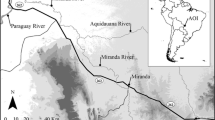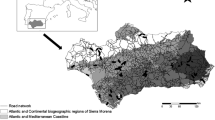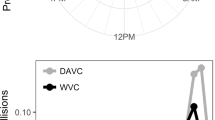Abstract
Collision with vehicles is a major if not the dominant source of mortality for owls. Despite this, there has been no study to date on Barred Owl-vehicle collisions, a species that breeds in densely-populated suburban neighborhoods with high road density. We capitalized on the availability of a large dataset of the locations of Barred Owls hit by vehicles and brought to a rehabilitation center in Charlotte, North Carolina, USA to investigate the factors underlying collision incidence. Using autologistic regressions and multi-model inference, we found that the explanatory variables with the largest effects on the likelihood of a Barred Owl-vehicle collision were speed limit, road width, and habitat suitability within 825 m of roads, in that order. Speed limit and habitat suitability had positive effects whereas road width had a negative effect. Our results are in agreement with existing studies of birds that have investigated the relative effects of road features and landscape structure in demonstrating the greater importance of the former. Future research should include systematic Barred Owl roadkill surveys that account for sampling biases in order to determine the importance of roads as a source of mortality for the species and to gain a better understanding of the effects of roadway design on the incidence of Barred Owl-vehicle collisions.



Similar content being viewed by others
References
Augustin NH, Mugglestone MA, Buckland ST (1996) An autologistic model for the spatial distribution of wildlife. J Appl Ecol 33:339–347
Barrientos R, Bolonio L (2009) The presence of rabbits adjacent to roads increases polecat road mortality. Biodivers Conserv 18:405–418
Bartoń K (2014) Package ‘MuMIn’. R package version 1.10.5
Baudvin H (1997) Barn owl (Tyto alba) and long-eared owl (Asio otus) mortality along motorways in Bourgogne-Champagne: report and suggestions. In: Duncan JR, Johnson DH, Nicholls TH (eds) Biology and conservation of owls of the Northern Hemisphere. General Technical Report NC-190, USDA Forest Service, St. Paul, pp 58–61
Baudvin H (2004) Motorway mortality of birds of prey and owls in the east of France. In: Chancellor RD, Meyburg B-U (eds) Raptors worldwide: proceedings of the 6th world conference on birds of prey and owls. World Working Group on Birds of Prey and Owls, Towcester, pp 787–793
Baudvin H, Genot JC, Muller Y (1991) Les rapaces nocturnes. Sang de la Terre, Paris
Bierregaard RO, Harrold ES, McMillian MA (2008) Behavioral conditioning and techniques for trapping barred owls (Strix varia). J Raptor Res 42:410–414
Bishop CA, Brogan JM (2013) Estimates of avian mortality attributed to vehicle collisions in Canada. Avian Conserv Ecol 8(2):2. doi:10.5751/ACE-00604-080202
Bivand R et al (2014) Package ‘spdep’. R package version 0.5-77
Bjornstad ON (2013) Package ‘ncf’. R package version 1.1-5
Borda-de-Água L, Grilo C, Pereira HM (2014) Modeling the impact of road mortality on barn owl (Tyto alba) populations using age-structured models. Ecol Model 276:29–37
Boves TJ, Belthoff JR (2012) Roadway mortality of barn owls in Idaho, USA. J Wildl Manag 76:1381–1392
Burnham KP, Anderson DR (2002) Model selection and multimodel inference: a practical information-theoretic approach. Springer, New York
Case RM (1978) Interstate roadkilled animals: a data source for biologists. Wildl Soc Bull 6:8–13
City of Charlotte (2013) Historical data. Charlotte-Mecklenburg Planning Department, City of Charlotte. http://charmeck.org/city/charlotte/planning/ResearchandGIS/Pages/HistoricalData.aspx. Accessed 23 Sept 2014
Clevenger AP, Chruszczc B, Gunson KE (2003) Spatial patterns and factors influencing small vertebrate fauna roadkill aggregations. Biol Conserv 109:15–26
Colino-Rabanal VJ, Lizana M, Peris SJ (2011) Factors influencing wolf Canis lupus roadkills in Northwest Spain. Eur J Wildl Res 57:399–409
Danks ZD, Porter WF (2010) Temporal, spatial, and landscape habitat characteristics of moose-vehicle collisions in western Maine. J Wildl Manag 74:1229–1241
Dean WRJ, Milton S (2003) The importance of roads and road verges for raptors and crows in the Succulent and Nama-Karoo, South Africa. Ostrich 74:181–186
Dykstra CR, Simon MM, Daniel FB, Hays JL (2012) Habitats of suburban barred owls (Strix varia) and red-shouldered hawks (Buteo lineatus) in southwestern ohio. J Raptor Res 46:190–200
Erickson WP, Johnson GD, Young DP Jr. (2005) A summary and comparison of bird mortality from anthropogenic causes with an emphasis on collisions. In: Ralph CJ, Rich TD (eds) Bird conservation implementation and integration in the Americas: proceedings of the third international Partners in Flight conference. General Technical Report PSW-GTR-191, USDA Forest Service, Albany, pp 1029–1042
ESRI (2012) ArcGIS 10.1 software. ESRI, Redlands
Fahrig L, Rytwinski T (2009) Effects of roads on animal abundance: an empirical review and synthesis. Ecol Soc 14(1):21, http://www.ecologyandsociety.org/vol14/iss1/art21/
Fajardo I (2001) Monitoring non-natural mortality in the barn owl (Tyto alba), as an indicator of land use and social awareness in Spain. Biol Conserv 97:143–149
Fajardo I, Pividal V, Trigo M, Jimenez M (1998) Habitat selection, activity peaks and strategies to avoid road mortality by the Little Owl Athene noctua: a new methodology for owl research. Alauda 66:49–60
Farmer RG, Brooks RJ (2012) Integrated risk factors for vertebrate roadkill in southern Ontario. J Wildl Manag 76:1215–1224
Forman RTT (2000) Estimate of the area affected ecologically by the road system in the United States. Conserv Biol 14:31–35
Forman RTT, Alexander LE (1998) Roads and their major ecological effects. Annu Rev Ecol Syst 29:207–231
Fry JA et al (2011) National land cover database for the conterminous United States. Photogramm Eng Remote Sens 77:859–864
Gomes L, Grilo C, Silva C, Mira A (2009) Identification methods and deterministic factors of owl roadkill hotspot locations in Mediterranean landscapes. Ecol Res 24:355–370
Google Inc. (2013) Google Earth software. Google Inc., Mountain View. https://www.google.com/earth/
Grilo C et al (2012) Individual spatial responses towards roads: implications for mortality risk. PLoS ONE 7(9), e43811. doi:10.1371/journal.pone.0043811
Grossman SR, Hannon SJ, Sánchez-Azofeifa A (2008) Responses of great horned owls (Bubo virginianus), barred owls (Strix varia) and northern saw-whet owls (Aegolius acadicus) to forest cover and configuration in an agricultural landscape in Alberta, Canada. Can J Zool 86:1165–1172
Gunson KE, Schueler FW (2012) Effective placement of road mitigation using lessons learned from turtle crossing signs in Ontario. Ecol Restor 30:329–334
Hager SB (2009) Human-related threats to urban raptors. J Raptor Res 43:210–226
Harrold ES (2003) Barred owl (Strix varia) nesting ecology in the southern piedmont of North Carolina. Thesis, University of North Carolina at Charlotte
Hernandez M (1988) Road mortality of the little owl (Athene noctua) in Spain. J Raptor Res 22:81–84
Hochberg Y (1988) A sharper Bonferroni procedure for multiple tests of significance. Biometrika 75:800–802
Homer C et al (2007) Completion of the 2001 National Land Cover Database for the conterminous United States. Photogramm Eng Remote Sens 73:337–341
Hosmer DW Jr, Lemeshow S (2000) Applied logistic regression. Wiley, New York
Illner H (1992) Road deaths of Westphalian owls: methodological problems, influence of road type and possible effects on population levels. In: Galbraith CA, Taylor IR, Percival S (eds) The ecology and conservation of European owls: proceedings of the symposium held at Edinburgh University. UK Nature Conservation No. 5, Joint Nature Conservation Committee, Peterborough, pp 94–100
Jancke S, Giere P (2011) Patterns of otter Lutra lutra road mortality in a landscape abundant in lakes. Eur J Wildl Res 57:373–381
Jones ME (2000) Road upgrade, road mortality and remedial measures: impacts on a population of eastern quolls and Tasmanian devils. Wildl Res 27:289–296
Joyce TL, Mahoney SP (2001) Spatial and temporal distributions of moose-vehicle collisions in Newfoundland. Wildl Soc Bull 29:281–291
Kociolek AV, Clevenger AP, Clair CCS, Proppe DS (2011) Effects of road networks on bird populations. Conserv Biol 25:241–249
Legendre P, Legendre L (1998) Numerical ecology. Elsevier, Amsterdam
Lele SR, Keim JL, Solymos P (2014) Package ‘ResourceSelection’. R package version 0.2-4
Loos G, Kerlinger P (1993) Road mortality of saw-whet and screech-owls on the Cape May Peninsula. J Raptor Res 27:210–213
Mason JS (2004) The reproductive success, survival, and natal dispersal of Barred Owls (Strix varia) in rural versus urban habitats in and around Charlotte, North Carolina. Thesis, University of North Carolina at Charlotte
Massemin S, Zorn T (1998) Highway mortality of Barn Owls in northeastern France. J Raptor Res 32:229–232
Massemin S, Le Maho Y, Handrich Y (1998) Seasonal pattern in age, sex and body condition of barn owls Tyto alba killed on motorways. Ibis 140:70–75
Mazur KM, James PC (2000) Barred owl (Strix varia). Cornell Lab of Ornithology. http://bna.birds.cornell.edu/bna/species/508. Accessed 16 Sept 2014
Meek WR, Burman PJ, Nowakowski M, Sparks TH, Burman NJ (2003) Barn owl release in lowland southern England: a twenty-one year study. Biol Conserv 109:271–282
Meentemeyer RK, Tang WW, Dorning MA, Vogler JB, Cunniffe NJ, Shoemaker DA (2013) FUTURES: multilevel simulations of emerging urban–rural landscape structure using a stochastic patch-growing algorithm. Ann Assoc Am Geogr 103:785–807
Meunier FD, Verheyden C, Jouventin P (2000) Use of roadsides by diurnal raptors in agricultural landscapes. Biol Conserv 92:291–298
Millsap BA (2002) Survival of Florida Burrowing Owls along an urban-development gradient. J Raptor Res 36:3–10
Mumme RL, Schoech SJ, Woolfenden GW, Fitzpatrick JW (2000) Life and death in the fast lane: demographic consequences of road mortality in the Florida Scrub-Jay. Conserv Biol 14:501–512
Ng JW, Nielsen C, St. Clair CC (2008) Landscape and traffic factors influencing deer-vehicle collisions in an urban environment. Hum-Wildl Confl 2:34–47
Nicholls TH, Warner DW (1972) Barred owl habitat use as determined by radiotelemetry. J Wildl Manag 36:213–224
R Core Team (2014) R: a language and environment for statistical computing. R Foundation for Statistical Computing, Vienna. http://www.R-project.org/
Ramp D, Wilson VK, Croft DB (2006) Assessing the impacts of roads in peri-urban reserves: road-based fatalities and road usage by wildlife in the Royal National Park, New South Wales, Australia. Biol Conserv 129:348–359
Riitters KH, Wickham JD (2003) How far to the nearest road? Front Ecol Environ 1:125–129
Rivers JW (1998) Unusually high rate of barn owl roadkills in Kansas. Kans Ornithol Soc Bull 49:43–44
Rodriguez B, Rodriguez A, Siverio F, Siverio M (2010) Causes of raptor admissions to a wildlife rehabilitation center in Tenerife (Canary Islands). J Raptor Res 44:30–39
Rytwinski T, Fahrig L (2012) Do species life history traits explain population responses to roads? A meta-analysis. Biol Conserv 147:87–98
Santos SM, Lourenco R, Mira A, Beja P (2013) Relative effects of road risk, habitat suitability, and connectivity on wildlife roadkills: the case of tawny owls (Strix aluco). PLoS ONE 8(11), e79967. doi:10.1371/journal.pone.0079967
Seiler A (2005) Predicting locations of moose-vehicle collisions in Sweden. J Appl Ecol 42:371–382
Smith AC, Koper N, Francis CM, Fahrig L (2009) Confronting collinearity: comparing methods for disentangling the effects of habitat loss and fragmentation. Landsc Ecol 24:1271–1285
Sousa J, Reto D, Filipe J, Leitno I, Grilo C, Ascensno F, Lourenço R, Marques A, Ferreira D, Santos-Reis M (2010) How do major roads affect barn owls? Distribution, space use, food source and mortality. In: Wagner PJ, Nelso D, Murray E (eds) International conference on ecology and transportation. Center for Transportation and the Environment, North Carolina State University, Raleigh, pp 407–417
Spellerberg IF (1998) Ecological effects of roads and traffic: a literature review. Glob Ecol Biogeogr 7:317–333
Tremblay MA, St Clair CC (2009) Factors affecting the permeability of transportation and riparian corridors to the movements of songbirds in an urban landscape. J Appl Ecol 46:1314–1322
Trombulak SC, Frissell CA (2000) Review of ecological effects of roads on terrestrial and aquatic communities. Conserv Biol 14:18–30
US Census Bureau (2010) 2010 census. US Census Bureau. http://www.census.gov/2010census/. Accessed 16 Sept 2014
US Census Bureau (2013) 2013 TIGER/Line shapefiles. US Census Bureau, Washington
US Department of Transportation (2012) Highway statistics 2012. Office of Highway Policy Information, Federal Highway Administration. http://www.fhwa.dot.gov/policyinformation/statistics/2012/index.cfm. Accessed 15 Sept 2014
Vogelmann JE, Howard SM, Yang LM, Larson CR, Wylie BK, Van Driel N (2001) Completion of the 1990s National Land Cover Data set for the conterminous United States from Landsat Thematic Mapper data and ancillary data sources. Photogramm Eng Remote Sens 67:650–662
Acknowledgments
We thank the Carolina Raptor Center for generously providing us access to their archives. We also thank Larry Barden for his candid and valuable insight throughout the course of our research and writing. This work was supported by the University of North Carolina at Charlotte.
Author information
Authors and Affiliations
Corresponding author
Electronic supplementary material
Below is the link to the electronic supplementary material.
ESM 1
(PDF 141 kb)
Rights and permissions
About this article
Cite this article
Gagné, S.A., Bates, J.L. & Bierregaard, R.O. The effects of road and landscape characteristics on the likelihood of a Barred Owl (Strix varia)-vehicle collision. Urban Ecosyst 18, 1007–1020 (2015). https://doi.org/10.1007/s11252-015-0465-5
Published:
Issue Date:
DOI: https://doi.org/10.1007/s11252-015-0465-5




